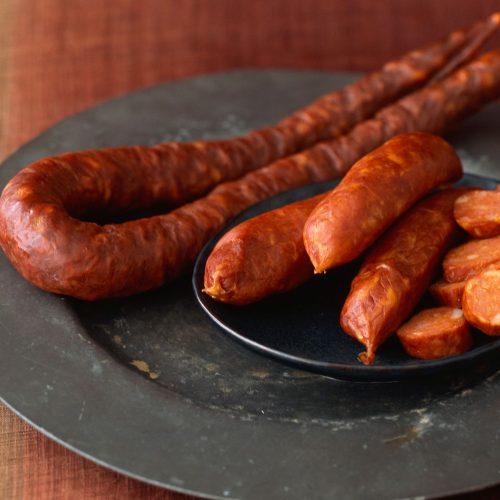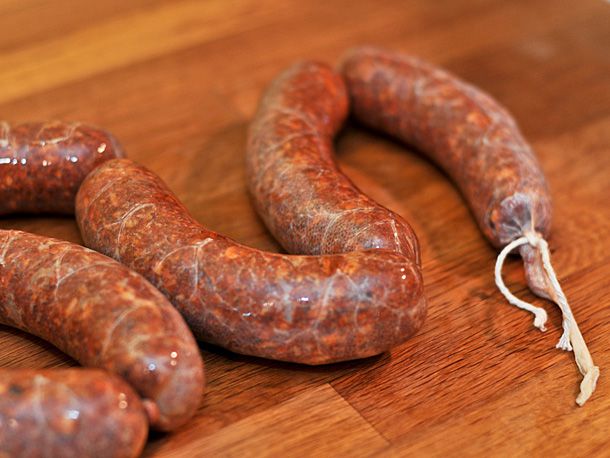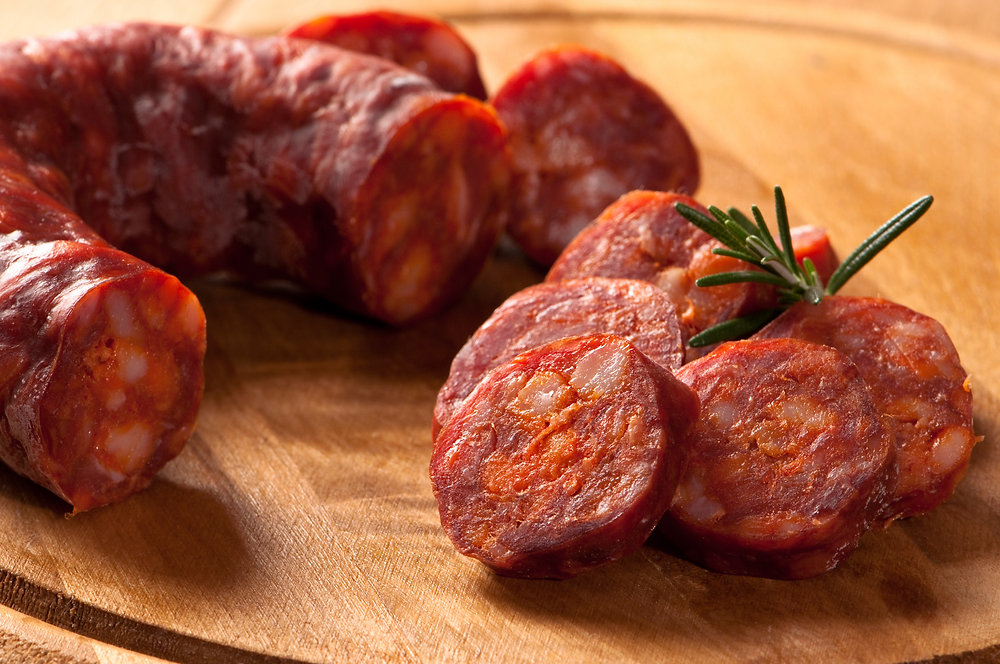During a recent exploration of Spain’s diverse and rich culinary landscape, I encountered the bold and vibrant flavors of Chorizo, a staple in Spanish cuisine that instantly captured my taste buds. This encounter led me to delve into the art of making Chorizo at home, discovering the intricacies of its preparation. Central to this flavorful journey are key ingredients: finely ground pork, tangy white vinegar, and smoky paprika, which coalesce to form the distinctive hearty and robust flavor characteristic of Chorizo. The pork provides a rich and succulent base, the vinegar introduces a subtle acidity that enhances the meat’s flavors, and the paprika imbues it with its iconic deep red color and smokiness. Through careful experimentation and a dedication to replicating the authentic taste experienced during my travels, I’ve mastered the recipe for homemade Chorizo. It is with great excitement that I now share this delightful culinary creation with you, inviting you to incorporate the warmth and passion of Spanish cooking into your own kitchen.

Chorizo
Equipment
- 1 small dish
- 1 large mixing basin
Ingredients
- 2 tablespoons white vinegar
- 2 cloves garlic
- 1 pinch ground cloves
- 1 pound ground pork
- 1/2 teaspoon coarse kosher salt
- 1 pinch ground cinnamon
- 1 teaspoon oregano
- 1 teaspoon coriander
- 3 tablespoons paprika
- 1 tablespoon ancho chili powder
- 1 tablespoon chili powder
- 1/2 tablespoon cumin
Instructions
- Paprika, cumin seeds, ancho chili flakes, normal cayenne pepper, garlic powder, dried cilantro, coarse sour cream, powdered cinnamon, and dried basil should all be combined in a small dish.
- To blend, mix everything.
- Combine the minced pork, chorizo spices, apple cider vinegar, and chopped garlic in a large mixing basin.
- With your hands, mix all of the ingredients until they are well incorporated.
- Use right away or save for later in your chili recipe.
Cooking tips about Chorizo

- Choosing the Right Chorizo: Understand the difference between Spanish and Mexican Chorizo. Spanish Chorizo is cured and firm, while Mexican Chorizo is usually sold fresh and needs to be cooked. Depending on your recipe, choose the appropriate type.
- Using Chorizo as an Ingredient: When using Chorizo in recipes, consider its strong flavor. Chorizo works brilliantly to add depth to soups, stews, and beans, infusing them with its distinctive paprika-rich taste. Start with a small amount and adjust according to your preference.
- Crisping Up Fresh Chorizo: If you’re cooking fresh Chorizo (particularly Mexican Chorizo), remove it from its casing and cook it in a pan over medium heat. Break it up with a wooden spoon until it’s thoroughly cooked and slightly crispy. This method releases its flavorful oils, which can be used to cook other elements of your dish, imbuing them with the Chorizo’s rich taste.
- Balancing Flavors: Given Chorizo’s robust flavor profile, including paprika, garlic, and other spices, it’s important to balance it with other ingredients. Pairing it with starches like potatoes or rice helps to absorb some of its intensities, making for a harmonious dish.
- Cooking Cured Chorizo: For dishes involving cured Chorizo, slicing it thinly and adding it towards the end of the cooking process can preserve its texture and flavor. It can be an excellent addition to pizzas, pastas, or served as part of a charcuterie board.
- Health Considerations: Chorizo is known for its high fat and salt content. To create a healthier dish, you can drain off excess fat after cooking the Chorizo, before adding other ingredients to the dish. Also, consider balancing your meal with plenty of vegetables or salads.
- Smoking Point Awareness: When frying or sautéing Chorizo, be mindful of its smoking point. Chorizo releases oils that can smoke if the pan is too hot. Cooking over medium heat is a good practice to ensure it cooks evenly without burning.
- Experimentation: Don’t hesitate to experiment with Chorizo in a variety of dishes. Its unique flavor complements many ingredients and can spice up traditional recipes, from scrambled eggs and breakfast hashes to sophisticated paellas and tapas.
Serving suggestions about Chorizo

- As Part of a Charcuterie Board: Serve Chorizo sliced thinly alongside other cured meats, cheeses, olives, and crusty bread for a vibrant and diverse charcuterie board. This setup encourages guests to explore different flavor combinations and creates a casual yet sophisticated dining experience.
- Within Breakfast Dishes: Incorporate Chorizo into breakfast or brunch dishes like scrambled eggs, omelets, or breakfast tacos for a spicy kick that starts the day off with robust flavors. The spice and heartiness of Chorizo pair well with the creaminess of eggs, elevating the overall dish.
- Added to Soups and Stews: Dice or slice Chorizo and add it to soups and stews to infuse them with its distinct paprika-rich flavor. It complements a wide range of ingredients, from hearty beans and lentils to vegetables and potatoes, contributing depth and warmth to any broth.
- As a Pizza Topping: Transform traditional pizza into a gourmet experience by adding slices of Chorizo. Its spicy and smoky notes elevate simple cheese pizzas or harmonize well with other toppings like bell peppers, onions, and even pineapple for a sweet-salty-spicy flavor profile.
- In Paellas or Rice Dishes: Incorporate Chorizo into Spanish paellas or other rice dishes. Its oils and spices seep into the rice, coloring it beautifully and lending the dish layers of flavor that are both comforting and complex.
- Paired with Seafood: Follow the Spanish tradition of pairing Chorizo with seafood, such as in dishes like “Chorizo al vino” (Chorizo cooked in wine) mixed with scallops, shrimp, or mussels. The contrast between the savory Chorizo and the sweetness of the seafood creates a harmonious and luxurious taste experience.
- With Pasta: Add Chorizo to pasta sauces or toss diced Chorizo with cooked pasta, olive oil, garlic, and fresh herbs for a simple yet flavorful dish. The Chorizo adds a punch of flavor that makes even the simplest pasta dish stand out.
- As Part of Tapas: Embrace its Spanish roots by serving Chorizo as part of a tapas spread, either cooked and served with toothpicks or combined with other small plates. This allows diners to enjoy the Chorizo in small, flavorful bites alongside other Spanish delicacies.
Top 5 FAQs about Chorizo

- What is Chorizo? Chorizo is a type of sausage that hails from Spain, known for its deep red color and distinctive smoky flavor. It is made from finely ground pork, seasoned with tangy white vinegar, and smoky paprika, capturing the essence of Spanish culinary traditions.
- What are the key ingredients in Chorizo? The essential ingredients that define Chorizo include finely ground pork, which provides a rich base; white vinegar, adding a tangy zest; and smoky paprika, giving Chorizo its iconic color and robust flavor profile. These components meld together during the curing process, creating a bold and flavorful sausage.
- How is Chorizo prepared and used in cooking? Chorizo can be incorporated into a myriad of dishes to enhance their flavor. Depending on whether it’s fresh or cured, Chorizo can be cooked in several ways. Fresh Chorizo, typically found in Mexican cuisine, is cooked by removing it from its casing and frying until crispy, often used to infuse dishes with its rich oils and flavors. Cured Spanish Chorizo is enjoyed sliced thin as part of charcuterie boards, added to soups, stews, or paellas, and even tossed into pasta or rice dishes, giving them a distinct smoky-spicy taste.
- Are there different types of Chorizo? Yes, two primary types of Chorizo are recognized: Spanish and Mexican. Spanish Chorizo is usually cured and firm, characterized by its deep smoky flavor, and can be eaten without additional cooking. Mexican Chorizo is generally sold fresh and must be cooked before consumption. It’s spicier and uses fresh chili peppers and vinegar, offering a very different flavor profile suitable for a variety of dishes.
- Can Chorizo be made at home, and what are some tips for doing so? Making Chorizo at home is indeed a delightful culinary adventure that offers a taste of Spain’s rich gastronomic heritage. Key tips include sourcing quality ground pork, using authentic smoky paprika for that characteristic Chorizo flavor, and not skipping on the white vinegar for its essential tanginess. Careful mixing of the spices and meat, followed by proper curing (for Spanish Chorizo), will yield a homemade sausage that brings the vibrant flavors of Spain into any kitchen.

Leave a Reply